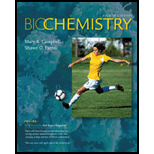
Concept explainers
RECALL How does the catalytic effectiveness of enzymes compare with that of nonenzymatic catalysts?
Interpretation:
The comparison between the catalytic effectiveness of the enzyme and the nonenzymatic catalysts.
Concept introduction:
The process through which the rate of a chemical reaction is increased is termed as catalysis. The functional proteins and some self-splicing ribonucleic acid molecules serve to increase the rate of a reaction and they are known as catalysts. In the biological system, they are known as enzymes.
Enzymes are largely organic in nature and are produced by the organism’s body itself, while catalysts can be organic or inorganic in nature. The catalysts and enzymes are not used up in the chemical reaction, they just alter the rate of the reaction.
Answer to Problem 1RE
The enzymatic catalysts are mainly proteins and some RNA molecules that show higher catalytic activity in terms of specificity, the speed of the reaction than nonenzymatic catalysts, which are organic or inorganic molecules.
Explanation of Solution
The difference between the enzymatic catalysts and nonenzymatic catalysts are as follows:
| Enzymatic catalyst | Nonenzymatic catalyst |
| The enzymatic catalysts are complex proteins and speed up the chemical reactions that occur in the biological system. | The nonenzymatic catalyst increases or decreases the rate of chemical reactions that occur outside the biological system. |
| The enzymatic catalysts are highly specific in nature. | The nonenzymatic catalysts are not very specific in nature. |
| The enzymatic catalysts increase the rate of reaction by an order of 1020. | The nonenzymatic catalysts are comparatively slower and increase the rate of reaction about 102 to 104 times. |
| The enzyme catalyst requires optimum physiological conditions. | The nonenzymatic catalysts require high temperature or pressure. |
Therefore, it can be concluded that the catalytic effectiveness of the enzymatic catalyst is higher than that of a nonenzymatic catalyst. The enzymatic catalyst is more specific in nature than the nonenzymatic catalyst.
Want to see more full solutions like this?
Chapter 6 Solutions
Biochemistry
- REFLECT AND APPLY Why is it somewhat misleading to study bio- chemical pathways separately?arrow_forwardREFLECT AND APPLY Other things being equal, what is a potential disadvantage of an enzyme having a very high affinity for its substrate?arrow_forwardREFLECT AND APPLY Why is it useful to plot rate data for enzymatic reactions as a straight line rather than as a curve?arrow_forward
- REFLECT AND APPLY List two classes of compounds derived from arachidonic acid. Suggest some reasons for the amount of biomedical research devoted to these compounds.arrow_forwardREFLECT AND APPLY Would nature rely on the same enzyme to catalyze a reaction either way (forward or backward) if the DG were 0.8kcalmol1? If it were 5.3kcalmol1?arrow_forwardREFLECT AND APPLY Argue logically that the urea cycle should not have evolved. Then, logically counter your argument.arrow_forward
- REFLECT AND APPLY Why can we say that having a pure non- competitive inhibitor present is similar to just having less enzyme present?arrow_forwardRECALL Show graphically how the reaction velocity depends on the enzyme concentration. Can a reaction be saturated with enzyme?arrow_forwardREFLECT AND APPLY In Section 2-4, we said that at the equivalence point of a titration of acetic acid, essentially all the acid has been converted to acetate ion. Why do we not say that all the acetic acid has been converted to acetate ion?arrow_forward
 BiochemistryBiochemistryISBN:9781305961135Author:Mary K. Campbell, Shawn O. Farrell, Owen M. McDougalPublisher:Cengage Learning
BiochemistryBiochemistryISBN:9781305961135Author:Mary K. Campbell, Shawn O. Farrell, Owen M. McDougalPublisher:Cengage Learning
